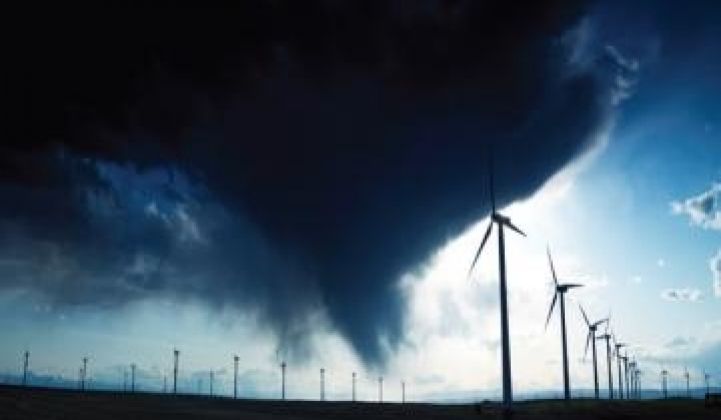"We're growing dramatically," Lawrence Berkeley National Laboratory staff scientist Ryan Wiser said of the wind industry's 2009 performance. "We're on a path to achieve much higher levels of wind." This is in stark contrast to wind's 2010 first half performance, which American Wind Energy Association CEO Denise Bode characterized as "dismal."
The 2009 Wind Technologies Market Report, by Wiser and Mark Bolinger of Lawrence Berkeley National Laboratory (LBNL), describes a record-breaking 2009. Yet a 71 percent drop in installation in the first half of 2010 forebodes a completely different kind of year. Things will pick up in the second half, but the forecast is for a 20 percent to 45 percent year-on-year reversal. Careful scrutiny of the LBNL report turns up possible telltale signs of the turnaround that are an indication of things to come.
With 9,994 megawatts of new capacity in 2009, the U.S. industry took over world leadership in cumulative installed capacity (35,155 megawatts). But the U.S. came in second in the world in new capacity installed for 2009, behind China's 13,750 megawatts. But this did not concern Wiser. "Good for the planet," he said.
On the other hand, though wind was the second biggest source of new electricity generation in the U.S. for the fifth consecutive year, its overall proportion fell. Natural gas upped its prominence slightly by tapping abundant new shale gas reserves that began driving down natural gas and electricity prices. The competition has, in 2010, further turned utilities away from wind.
"The drop [in wind's share] from 44 percent to 39 percent is one small indicator," Wiser said. "I think the larger indicator is the significant drop in natural gas prices."
Looking at LBNL's map of U.S. wind projects is revealing in a different way. Texas and California, the traditional powers, show lots of established and new projects. Most notably, states in the Midwest, this nation's "Saudi Arabia of wind energy," are rapidly adding installations. Iowa, Minnesota, Illinois, Indiana and North Dakota have penetrated the top-ten installed capacity lists. But almost the entire Southeast, where the coal-and-nuclear-owned Senators who block legislation supporting renewable energy are regularly re-elected, remains devoid of wind development.
"Are there some concerns there? Sure," Wiser said when asked whether the political opposition would stop U.S. wind from growing. But, he insisted, "there's little doubt the U.S. can -- if there is the motivation to do so."
There is no mistaking, however, the meaning of the map that shows absolutely no operating offshore wind projects. Offshore could be where wind's biggest potential is. The Market Report heralds thirteen offshore projects in the permitting and development stages in 2009. Wiser admitted this was not entirely good news.
"There were a lot of activities towards offshore wind that give the sector some hope," Wiser said. "There were some PPAs signed," he continued, though the prices are "pretty high." And, "they're just now waiting for the siting, permitting, financing, and development process." He laughed. "There are still some hurdles to overcome before we get a project in the water."
Perhaps the most telling statistic from the Market Report is that 300 gigawatts of proposed projects are still awaiting permission to connect to the grid. "If we were to achieve 300 gigawatts of wind, that would be almost twenty percent of U.S. electricity supply," Wiser said.
This was where 2009's good news met 2010's bad news. "Seventeen percent of the potential wind production in Texas in the year 2009 was capable of delivering electricity but did not because transmission was simply not available," Wiser said. "That's one of the reasons we're going to see a slower wind capacity growth in Texas this year. The transmission is simply not there."
And Texas is just the beginning, Wiser said. "If we want to continue to grow the wind sector at the rate we have been growing it, it's pretty clear new and significant transmission investments are going to be necessary."
The Market Report notes progress last year on some new transmission projects and on efforts to pre-designate transmission-accessible renewable energy zones. But the daunting questions of who has authority over the final siting of lines and who will pay for them remained unresolved barriers in 2009.
The renewables were buoyed last year by federal support that relieved them of dependence on the tax equity market. TARP and the Recovery Act provided Treasury grants, increased production, investment and manufacturing tax credits, loan guarantees and development programs. But Wiser admitted there is, as a result of what has happened in 2010, a lot less certainty that wind can achieve its goal of providing 20% of U.S. power by 2030 than is reflected in the Market Report's 2009-based assessment.
Partisan gridlock has set in. A slow economic recovery is expected to keep electricity demand low and abundant shale reserves are expected to keep natural gas prices low. Wind costs are expected to rise. Without policy support extending wind's freedom from tax equity markets, the situation appears grim.
"The entire tax equity market never exceeded about five-and-a-half billion dollars a year," Wiser said. That is roughly adequate, he said, to build 3,000 megawatts of new capacity. If projects were only half-funded through such investment and investment miraculously doubled, Wiser speculated, it would perhaps be enough to build 12,000 megawatts of new solar PV, solar power plant and wind power capacity. That is woefully short of what the renewable energies need to fulfill their potential. "So, yes," Wiser concluded. "I think we've got issues."



